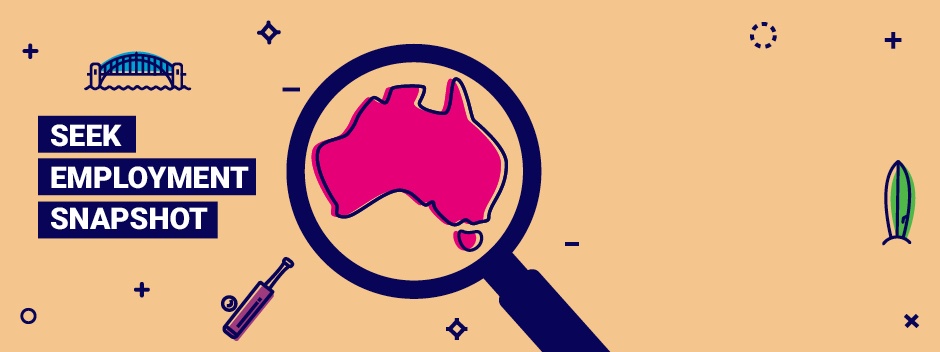Workforce impact revealed by new research
New research conducted on behalf of SEEK reveals how COVID-19 has impacted the working lives of Australians. Not surprisingly, the majority of candidates have experienced a change in their working situations during the pandemic – 80% of respondents have been impacted.
Casual and contract employees have borne much of the brunt of workforce changes – 30% of casuals and 21% of contractors have either lost their job or been stood down.
Meanwhile, 7% of all workers have taken a pay cut.

HR and people management platform Employment Hero has a range of resources to help businesses navigating changed working situations, including redundancy and stand-down templates. There are also templates to assist in ending or changing these decisions for businesses able to do so. You can find these resources here.
A boost in Healthcare
The pandemic has led to a reduction in working hours for one in four people. But 7% of workers, such as those in the Healthcare industry, have in fact experienced a lift in hours.
Dan Hobson, Company Director of specialist healthcare recruitment agency Hobson Healthcare, says that while there is an increase in demand for general medical services, acute care and pathology, the lift in telehealth services during COVID-19 may also be contributing to the trend.
“For telehealth and online health services, such as triage services, mental health reach out and GP appointments, we have seen a surge in demand for qualified health professionals across nursing, psychology, and general practitioners,” he says.
“There has also been a growing demand for non healthcare-qualified people in the industry, such as sales, health administration and customer service staff to assist with the role out of telehealth platforms.”

Applications spike for Call Centre & Customer Service
The impact of COVID-19 has led to fierce competition among candidates, which may be good news for employers looking for top talent or who are looking to fill roles fast.
SEEK’s data shows application rates for many industries have increased, especially in Call Centre & Customer Service. Kendra Banks, Managing Director, SEEK ANZ, says applications in the industry have grown more than six times over the past three weeks.
“Roles in Call Centre & Customer Service have seen a huge increase in demand,” she says. “We know first-time jobseekers and those who have been displaced from work value roles that don’t require specific qualifications or experience and which they can quickly start. When you combine this with the ability to work from home there are a huge number of people who these jobs appeal to right now.”
Working from home goes mainstream
Social distancing requirements during COVID-19 have made working from home the new normal for many organisations.
SEEK’s data shows 35% of people are working from home, but the figure jumps to 61% for office workers.
Kelly Van Nelson, Managing Director of Adecco Australia, says this signals the beginning of a “fundamental transformation in the world of work”.
“Many businesses have resisted home working options for various reasons, but the current crisis might well have proven to them that it can in fact work,” she says. “This will lead to a myriad of workplace changes impacting teamwork, productivity, collaboration, and communication, and managers need to agree on new rules of engagement with their team members to incorporate routines and rituals to support these changes.”
Nick Deligiannis, Managing Director of Hays Australia and New Zealand, adds that employers should continue to adopt a flexible approach during COVID-19 and promote flexibility and work-life balance when the crisis is over.
“There will be many people who would like to see some form of flexibility remain, at least for a part of their week, if not all, once we begin to transfer back into co-located workplaces,” he says.
“The experience of the past few weeks means they will be able to show evidence of their productivity, and managers will need to seriously consider how they can continue to offer some form of regular remote working to staff who would like it.”

Candidate confidence bounces back
In a positive sign for the job market, SEEK’s data shows candidates are beginning to feel more optimistic about their future job prospects.
In the middle of April, just 51% of people were optimistic. The figure has now bounced back to 60%, which is just slightly lower than in January, when the figure reached 62%.
The lift in optimism may be due to a flattening of the coronavirus curve in Australia. It may also prompt more candidates to start plotting their next career move or to upskill, so Van Nelson says employers should review their employee value proposition (EVP).
“As we progress through the current pandemic and move into a new normal, we will find that businesses need to refocus and rebuild teams that may have been slimmed down during the downturn,” she says.
“Having a strong EVP will ensure that your talent management strategy remains focused and aligned with business goals. Candidates looking for roles can easily identify what your business stands for, and a strong EVP is integral to ensuring great candidates fit great companies.”
Van Nelson adds that employers are facing a candidate-rich market due to the impact of COVID-19, but now is not the time to be complacent.
“It is vital for organisations to remain in a best-in-class position.”
This data is correct as of 4th May 2020
Source: Independent research conducted by Nature on behalf of SEEK. Interviewing 4,800 Australians annually.

